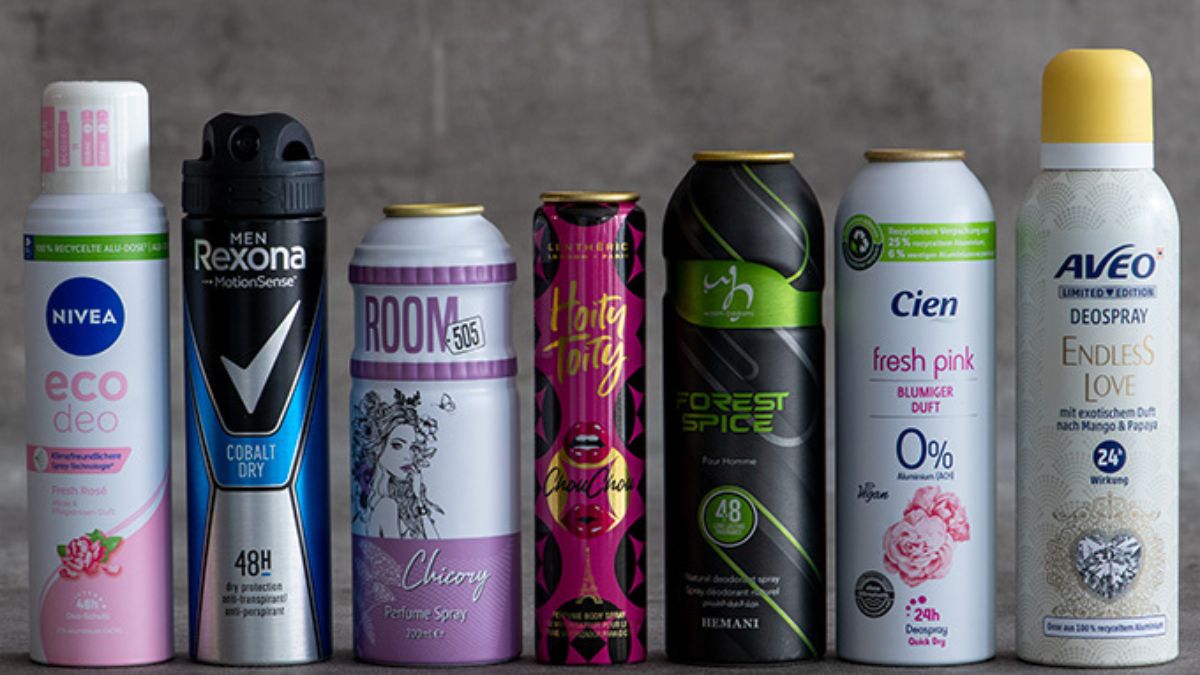BLOG
The Science Behind Sunscreen Sprays in Aerosol Cans

Sunscreen sprays have changed the way we protect our skin from the sun, offering a quick, even, and hassle-free application. The key to their effectiveness lies in their aerosol can technology. But how exactly do these cans work? What makes them different from traditional sunscreens? And how can you ensure maximum protection while using them? In this guide, we’ll break down the science behind aerosol sunscreen, expert tips for better application, and answers to frequently asked questions.
How Does an Aerosol Can Sunscreen Work?
Aerosol sunscreen works by using pressurized gas to deliver a fine mist of sunscreen evenly across the skin. Inside each can, three key components work together:
- Sunscreen Formula – The active ingredients that provide protection against UVA and UVB rays.
- Propellant – A pressurized gas that forces the sunscreen out of the can in a mist form.
- Aerosol Valve – A precision component that controls the spray pattern, ensuring an even and controlled application.
When the nozzle is pressed, the propellant pushes the sunscreen through the aerosol valve, breaking it into fine particles that spread smoothly over the skin. This even distribution helps to reduce missed spots and ensures better absorption.
Why Choose Aerosol Can Sunscreen?
Compared to traditional lotions and sticks, aerosol sunscreen offers several advantages:
- Quick & Easy Application – No need to rub it in extensively, just spray and go.
- Even Coverage – The mist provides uniform protection and reduces missed areas.
- Hard-to-Reach Areas – Great for covering your back, shoulders, and legs without assistance.
- Lightweight & Non-Greasy – Ideal for people who dislike the sticky feeling of lotion-based sunscreens.
Best Practices for Using Aerosol Sunscreen
To maximize the effectiveness of aerosol sunscreen, follow these expert tips:
- Shake the Can Well – This helps to mix the sunscreen and propellant properly.
- Hold the Can 6 Inches Away – Spraying too close can lead to uneven application.
- Apply Generously – A thin mist may not be enough; make sure to cover all exposed areas.
- Reapply Every Two Hours – Sunscreen wears off over time, especially after sweating or swimming.
- Use in a Well-Ventilated Area – Avoid inhaling the spray particles by applying it outdoors or in a ventilated space.
- Rub It In When Necessary – Though aerosol sunscreen is designed for even application, rubbing it in can enhance coverage.
Hidden Tricks to Improve Your Aerosol Sunscreen Experience
Want to get even more out of your sunscreen spray? Try these little-known hacks:
- Apply Before Going Outside – Allow at least 15 minutes for the sunscreen to fully absorb before sun exposure.
- Use on Hair & Scalp – A quick mist can protect your scalp from sunburn without making your hair greasy.
- Store in a Cool Place – Keeping it cool helps maintain the can’s pressure and prevents overheating.
- Apply a Second Layer – A second coat can help ensure complete coverage, especially in high-sun areas.
- Spray on Hands for Facial Application – Avoid inhalation by spraying onto your hands first and then applying to your face.
Frequently Asked Questions About Aerosol Can Sunscreen
Here are some of the most common questions people have about aerosol sunscreen:
- Is Aerosol Can Sunscreen as Effective as Lotion?
Yes, when applied correctly. Ensure thorough coverage and reapply regularly for the best protection.
- Can I Spray Sunscreen Directly on My Face?
It’s best to spray onto your hands first and then apply to avoid inhaling the mist.
- Are Aerosol Cans Safe for the Environment?
Most modern aerosol cans do not contain harmful CFCs, making them environmentally safer than older models.
- How Should I Store My Aerosol Can Sunscreen?
Keep it in a cool, dry place away from direct sunlight and excessive heat to maintain pressure stability.
- What Should I Do If the Nozzle Gets Clogged?
Try rinsing the nozzle under warm water to remove any blockages and ensure smooth spraying.
- Can I Travel with an Aerosol Can of Sunscreen?
Yes, but travel-size cans (under 3.4 oz or 100ml) are usually required for carry-ons on flights.
- Does Sunscreen Spray Expire?
Yes, typically after 2-3 years. Always check the expiration date before use.
- How Do I Ensure Even Application?
Spray in a steady, sweeping motion and rub it in for better absorption when necessary.
- What Is an Aerosol Valve, and Why Is It Important?
The aerosol valve controls the release of the sunscreen mist, ensuring a fine, consistent spray for uniform coverage.
- Where Can I Find High-Quality Aerosol Can Components?
Reliable aerosol can manufacturers provide top-tier components for efficient product dispensing.
Final Thoughts
Sunscreen sprays in aerosol cans have revolutionized sun protection by making it faster, easier, and more effective. Understanding the science behind these products allows you to apply them properly and get the best results. Whether you’re at the beach, hiking, or enjoying outdoor activities, aerosol sunscreen can be a game-changer in your skincare routine.
BLOG
8 Common Mistakes People Make When Moving to an Apartment – And How to Avoid Them

Moving to a new apartment can be an exciting yet stressful experience. Whether relocating across town or just a few blocks away, the process requires careful planning to avoid common mistakes that could make your move a nightmare. From forgetting to measure your furniture to underestimating the costs, many factors can make the move more complicated than it needs to be.
In this article, we’ll walk through the eight most common mistakes people make when moving to an apartment and share practical tips on how to avoid them. By staying organized and planning, you can ensure your move goes smoothly and without unnecessary stress.
1. Not Planning Ahead
One of the most common mistakes people make when moving is failing to plan. Without a clear plan, it’s easy to overlook important details, forget essential items, or leave everything until the last minute. This can lead to unnecessary stress, confusion, and a rushed move.
How to avoid it:
Start planning as early as possible. Create a checklist of all the tasks needed before, during, and after your move. This should include everything from booking a moving truck to setting up your utilities. Break the tasks into smaller, manageable steps and assign deadlines to ensure nothing is overlooked.
A timeline can help you stay on track. For example, start packing non-essential items a few weeks before your move and leave the essentials for the last few days. Preparing in advance gives you time to solve any problems that may arise and allows for a much smoother moving experience.
2. Underestimating the Costs
Another common mistake is underestimating the costs associated with moving. Many assume that moving is as simple as renting a truck, packing a few boxes, and calling it a day. However, moving costs can quickly increase, especially when you factor in moving supplies, transportation, and any unexpected fees.
How to avoid it:
Create a detailed moving budget. List all potential costs, such as moving truck rental, boxes, packing materials, and cleaning fees. Don’t forget to account for deposits, first-month rent, or utility setup fees for your new apartment.
A clear picture of your moving expenses can help you avoid financial surprises. Be sure to leave some wiggle room in your budget for unexpected costs, which often arise during the moving process.
3. Not Getting Professional Help
Moving heavy furniture and boxes can be physically exhausting, and it’s easy to make the mistake of trying to do it all yourself or relying on friends who may not have experience moving. While DIY moves seem cost-effective, they can quickly become a logistical nightmare.
How to avoid it:
Consider hiring professional movers, especially if you have large or delicate items. Moving companies have the equipment and expertise to handle heavy lifting, prevent damage to your belongings, and move everything safely and efficiently. While professional help may come with an extra cost, it can save you time, stress, and potential injury.
If hiring movers isn’t an option, make sure to enlist the help of trusted friends and family members who can help with the move. Whether you’re going DIY or professional, having a reliable team on board—friends or experienced staff from moving companies—makes a big difference in the moving process.
4. Not Decluttering Before the Move
One of the worst mistakes you can make when moving is bringing items you don’t need. Moving is a perfect opportunity to declutter and eliminate anything you haven’t used. Holding onto old or unnecessary items only adds to the stress of moving and can increase your moving costs since you’ll be paying to transport things you don’t need.
How to avoid it:
Before packing, go through each apartment room and decide what to keep. If something is no longer helpful or meaningful to you, consider donating, selling, or throwing it away. This can significantly reduce the number of items you need to pack, saving you time and money in the long run.
Decluttering also helps you start fresh in your new apartment. When surrounded by only the things you need, your new living space will feel more organized and less cluttered.
5. Forgetting to Measure Furniture and Doorways
It’s easy to assume that your furniture will fit in your new apartment, but this is a common mistake. You may find that your sofa, bed, or dining table doesn’t fit through the doorway or is too large for your new space. Without proper measurements, you could waste time and effort trying to fit pieces into rooms that won’t work.
How to avoid it:
Before you move, measure your furniture, doorways, and rooms in your new apartment. Note any tight spaces, narrow hallways, or unusual door sizes. If your furniture doesn’t fit, consider selling, donating, or swapping out oversized items before the move.
If you’re unsure whether a piece of furniture will fit, err on caution. It’s better to downsize before the move than to realize after you’ve settled that your furniture doesn’t work in the new space.
6. Overpacking Boxes
Packing your belongings may seem straightforward, but overpacking boxes is a common mistake that can lead to broken items, back pain, and an unnecessarily heavy load. Boxes that are too full or heavy can tear, making unpacking more difficult.
How to avoid it:
Pack boxes with a balance of weight and size. Avoid overloading boxes, especially with heavy items like books or dishes. Use smaller boxes for heavier items and larger boxes for lighter items. Fill empty spaces with packing paper or bubble wrap to prevent shifting during the move.
Remember to label each box clearly with its contents and destination room. This will help you quickly find what you need once you’ve moved into your new apartment.
7. Not Preparing for the New Apartment’sApartment’s Conditions
You’ve packed up your life and are ready for the big move, but the job isn’t over once you enter your new apartment. A common mistake is not checking the apartment’s condition before moving. You may overlook issues like faulty electrical outlets, inadequate heating or cooling, or poor cleanliness until you move in.
How to avoid it:
Before moving in, schedule a walk-through of the new apartment to check for any maintenance issues. Test appliances, light fixtures, and HVAC systems. If anything is broken or needs attention, contact the landlord or property manager before moving in so they can address it.
Additionally, it’s a good idea to arrange for utilities (water, electricity, internet, etc.) to be set up before your move-in date. That way, you won’t
8. Ignoring the Legal and Lease Details
Many people are so eager to get settled into their new apartment that they overlook the finer details of their lease agreement. Failing to fully understand the terms of your lease or forgetting to set up renters’ insurance can cause significant problems down the line.
How to avoid it:
Before signing the lease, read through the entire document carefully. Ensure you understand the terms, including rent payments, deposits, and any restrictions on the property. It’s also crucial to arrange renters’ insurance. While landlords may have insurance for the building, renters’ insurance protects your personal belongings in case of theft, fire, or natural disaster.
Taking the time to review these details will help ensure that you’re not caught off guard later on.
Conclusion
Moving to a new apartment can be an exciting, fresh start, but it’s also a task that requires careful planning and attention to detail. By avoiding these eight common mistakes, you can make your move much smoother, less stressful, and more enjoyable. Start early, budget wisely, and don’t hesitate to ask for help when needed. A well-executed move will set you up for success in your new home.
BLOG
How to create a natural and dense 40-inch lace wig style – Luvme Hair transformation full process analysis

As a professional hair stylist, I often receive inquiries from customers for cost-effective wig styles. Today, I will take Luvme Hair’s 40 inch lace wig as an example to share a complete styling transformation plan. And we will share a lot of tips here on how to style a long wig like that. Additionally, we earn exclusive bonuses from the famous hair brand and new customers can enjoy up to 30% first order discount, helping you easily start your beautiful transformation journey.
1. Basic selection and structural analysis
This 13×4 front lace wig adopts a 200% density setting, and the 40-inch length can meet most styling needs. The actual evaluation found that although its original hair volume meets the basic standard, it still needs to be enhanced in density when creating a red carpet-level fluffy effect. It is recommended to give priority to the bottom net structure with an adjustable elastic band to facilitate the subsequent hair volume supplementation operation.
- Analysis of hair volume enhancement technology
For the problem of insufficient hair volume in the occipital area, it is recommended to use track-type hair volume enhancement technology. The specific steps are as follows:
Prepare two sets of 36-inch matching hair bundles (it is recommended to use Luvme Hair products similar to the main hair quality)
Use low-temperature hot melt glue to precisely bond along the original weaving track
Focus on strengthening the bonding points in the triangle area behind the neck to maintain the elasticity of the bottom net
Through comparative testing, this technology can increase the visual hair volume by about 35%, while maintaining the natural drape when the wig is worn.
- key steps for color customization
The use of layered coloring technology can effectively improve the realism of the shape:
Use professional hair dye (recommended Argan Oil 1B color) mixed with 30vol hydrogen peroxide
Use watercolor techniques to process the transition area of the hair tail to create a 0.8-1.2cm natural growth effect
A special plastic scraper assists in completing the lace knot bleaching to avoid chemical damage to the bottom of the net
Special attention: When using a spiral brush to touch up the root color in the forehead area, it is recommended to maintain a 15° tilt angle to prevent pigment deposition.
- Advanced styling techniques
After completing the basic treatment, improve the degree of completion through the following steps:
Use ceramic straighteners for piece-by-piece ironing (temperature controlled at 180°C)
Retain 0.3-0.5cm lace edge for secondary styling adjustment
Combination of elastic fixing band + medical-grade adhesive to ensure 8 hours of firmness
The final presentation effect should achieve a consistent swing amplitude of the hair, and the hairline transition area should retain 3-5 hair strands/square centimeter of natural hair flow.
- Long-term maintenance and styling iteration
5.1 Cleaning and maintenance system
Use PH5.8 weak acid shampoo every week
Perform silicone oil care every month (hydrolyzed keratin formula is recommended)
Use a suspended bracket when storing to avoid hair bending
5.2 Styling cycle management
Daily styling: Use a negative ion comb after each removal
Deep maintenance: Protein repair is required after every 15 wears
Life assessment: Up to 80-100 styling cycles under standard use
For readers ready to elevate their styling game, you need to pick the right wig for yourself to unlock your beauty. Unlike easily-tangled synthetic wig, natural human hair wigs will look more natural and realistic. What’s most important is that they are easy to maintain. Now Luvme Hair is offering exclusive deals for all their human hair wigs, check below:
New Customer Special – Get 30% off your entire purchase with code: SNU30
General Discount – Get 26% off with code: SMC26
Spend & Save Deals:
SMC19 – Save $19 on orders over $99
SMC59 – Save $59 on orders over $219
SMC100 – Save $100 on orders over $349
- Professional Stylist Summary
This solution successfully upgrades basic wigs to high-end custom styling through systematic density reconstruction, color transition and structure optimization technology. The key is to grasp the mechanical balance point of hair volume supplementation and the micro-gradient control of color processing. It is recommended to perform professional maintenance after every 15-20 uses, and the use of acid shampoo (PH5.5-6.0) can extend the service life by more than 30%. After mastering these core technologies, all kinds of synthetic hair products can glow with high-end texture and provide more possibilities for styling creation.
It is worth emphasizing that 90% of the transformation effect depends on the quality level of the basic hair products. Choose products from professional brands such as Luvme Hair, whose standardized production process can ensure that the error of hair distribution per square centimeter is ≤3%, laying a high-quality foundation for later transformation. It is recommended that practitioners regularly use hair density detectors for quantitative analysis, and establish a personalized transformation database based on customer head shape data to continuously improve styling accuracy.
BLOG
The Evolving Landscape of Mobile Messaging and Automation

Mobile messaging has undergone significant transformations over the past decade, evolving from simple text messages to sophisticated platforms that integrate automation and artificial intelligence. This article explores the dynamic changes in mobile messaging and automation, highlighting key trends and innovations shaping the industry.
The Rise of Mobile Messaging Apps
The advent of smartphones revolutionized communication, leading to the proliferation of mobile messaging apps. Platforms like WhatsApp, Facebook Messenger, and WeChat have become integral to daily communication, offering features beyond traditional SMS. These apps provide multimedia sharing, voice and video calls, and group chats, making them versatile tools for personal and professional use.
Integration of Automation in Messaging
Automation has become a cornerstone of modern mobile messaging. Businesses leverage automated messaging systems to streamline customer interactions, enhance engagement, and improve efficiency. Chatbots, powered by artificial intelligence, can handle customer inquiries, provide support, and even facilitate transactions. This integration of automation not only saves time but also ensures consistent and accurate responses.
The Role of AI in Enhancing Messaging
Artificial intelligence plays a pivotal role in advancing mobile messaging. AI algorithms analyze user behavior and preferences, enabling personalized communication. Predictive text, language translation, and sentiment analysis are some AI-driven features that enhance user experience. Moreover, AI-powered chatbots can learn from interactions, continuously improving their performance and providing more relevant responses.
Security and Privacy Concerns
As mobile messaging evolves, security and privacy have become paramount concerns. With the increasing amount of personal and sensitive information shared through messaging apps, robust encryption and data protection measures are essential. End-to-end encryption ensures that messages are only accessible to the intended recipients, safeguarding user privacy. Additionally, regulatory frameworks like GDPR and CCPA mandate stringent data protection practices, ensuring user trust and compliance.
The Future of Mobile Messaging and Automation
The future of mobile messaging and automation promises exciting developments. Emerging technologies like 5G and the Internet of Things (IoT) will further enhance connectivity and communication capabilities. Businesses will continue to adopt mass texting services to reach larger audiences efficiently. Moreover, advancements in AI will lead to more sophisticated chatbots and automated systems, offering seamless and intuitive user experiences.
Conclusion
The landscape of mobile messaging and automation is continuously evolving, driven by technological advancements and changing user expectations. From the rise of messaging apps to the integration of AI and automation, these innovations are transforming how we communicate. As security and privacy remain critical, the industry must adapt to ensure safe and reliable messaging solutions. The future holds immense potential, promising more efficient, personalized, and secure communication experiences for users worldwide.
-

 BLOG4 months ago
BLOG4 months agoLiteroticatags: Exploring the World of Erotica and Its Online Community
-

 BLOG2 months ago
BLOG2 months agoSlothokiturbo.net: Exploring the World of Online Gaming and Community
-

 BLOG4 months ago
BLOG4 months agoErothtos: Understanding Its Role in Today’s World 2025
-

 BLOG3 months ago
BLOG3 months agoUse 1.5f8-p1uzt – A Comprehensive Guide!
-

 TECH4 months ago
TECH4 months agoMansrufer: Pioneering Progress in Technology
-

 BLOG4 months ago
BLOG4 months agoWatchmenontheall Calvin: An Exploration of Themes, Characters, and Significance
-

 TECH4 months ago
TECH4 months agoEggFinder TX Rev C5: A Comprehensive Review and Guide
-

 FASHION3 months ago
FASHION3 months agoAchieve the Perfect Beard with Black Male Beard Products
